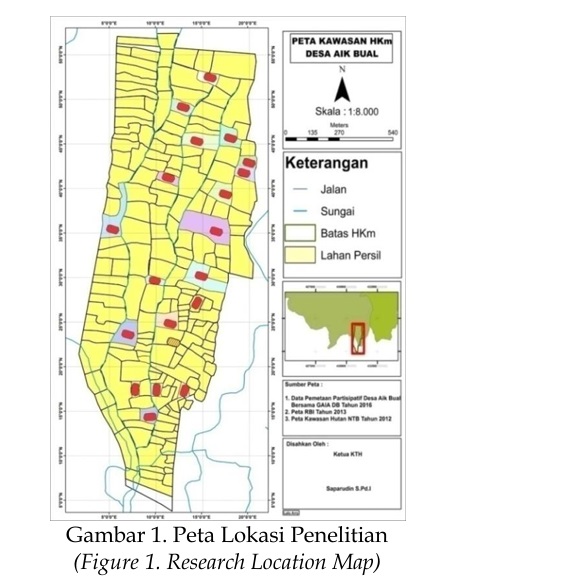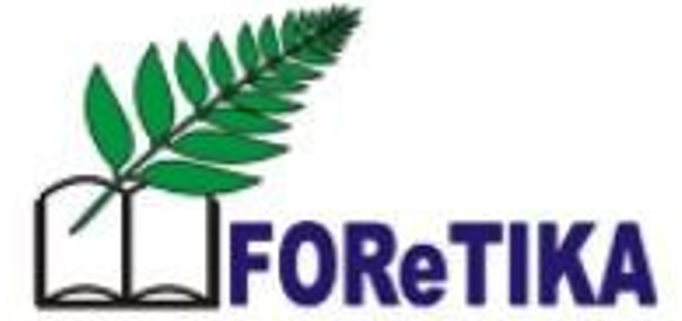Evaluasi Pertumbuhan Hasil Hutan Bukan Kayu Di Hutan Kemasyarakatan Aik Bual Kabupaten Lombok Tengah
Growth Evaluation of Non-Timber Forest Products in The Aik Bual Community Forest, Central Lombok Regency
DOI:
https://doi.org/10.22219/avicennia.v7i1.33936Keywords:
HHBK, Pertumbuhan, Indeks Dominansi, Kerapatan VegetasiAbstract
The sustainable management of forest resources has become increasingly important, particularly in community-managed forests where non-timber forest products (NTFPs) play a crucial role in local livelihoods and biodiversity conservation. This study aims to identify the types of NTFPs, the density and diversity of vegetation, and the average growth of NTFPs in the Community Forest (HKm) of Aik Bual. The research utilized a descriptive method and was conducted from August to September 2022 on HKm land in Aik Bual Village, Central Lombok, which received enrichment assistance for NTFP plants. The study population consisted of 164 HKm farmers, with an average land ownership of 50-60 ares. The sample used in this study comprised 20 plots managed by farmers. On these plots, a main plot of 25 m x 40 m and subplots of 20 m x 20 m and 10 m x 10 m were established. In the 25 m x 40 m plots, all NTFPs were surveyed, while other vegetation at tree and pole levels was measured in the 20 m x 20 m and 10 m x 10 m subplots. Parameters measured included diameter, height, and vegetation type. The analysis included vegetation diversity, density, dominance index, and NTFP growth. The results showed that there are nine types of NTFPs in the Community Forest of Aik Bual, namely avocado, durian, guava, mango, jackfruit, cocoa, silk cotton tree, melinjo tree, and sapodilla. Additionally, five types of non-wood forest products were identified. The vegetation density at the tree level in HKm Aik Bual was 515 individuals/ha, while at the pole level it was 545 individuals/ha. The highest importance value index (IVI) at the tree level was recorded for rajumas and mahogany, with values of 82% and 78,70%, respectively. At the pole level, durian and avocado had the highest IVI, with values of 123,69% and 70,08%, respectively. The dominance index at the tree level was dominated by rajumas and mahogany with a value of 0,07, while at the pole level, durian dominated with a value of 0,17. The average diameter growth for avocado at ages 1, 4, 5, 10, and 20 years was 1,49 cm/year, 2,42 cm/year, 2,55 cm/year, 1,98 cm/year, and 1,64 cm/year, respectively. For durian, the average diameter growth at these ages was 1,43 cm/year, 2,76 cm/year, 2,35 cm/year, 1,68 cm/year, and 1,71 cm/year. The average height growth for avocado at ages 1, 4, 5, 10, and 20 years was 1,33 m/year, 1,42 m/year, 1,62 m/year, 1 m/year, and 0,60 m/year, respectively. For durian, the average height growth at these ages was 1,24 m/year, 1,39 m/year, 1,50 m/year, 1,07 m/year, and 0,71 m/year.
Keywords: NTFS, Growth, Dominance Index, Vegetation Density
Downloads
References
Ardhana I.P.G. (2012). Ekologi Tumbuhan. Denpasar: Udayana University Press.
Fitriyani, A., Riniarti, M., & Duryat, D. (2020). Inventarisasi Hasil Hutan Bukan Kayu Pada Tanaman MPTS Di Hutan Desa Sukaraja KPH Rajabasa. Gorontalo Journal of Forestry Research, 3(1), 1.
Ganesid, M. A. P., Burhanuddin., & Manurung T. F. (2019). Keanekaragaman Jenis Vegetassi Di Cagar Alam Lho Fat Pun Pie Kecamatan Monterado Kabupaten Bengkayang. Jurnal Hutan Lestari. 7(1) : 86-96.
Ginting, A., Nugroho, Y., & Susilawati, S. (2021). Evaluasi Pertumbuhan Dan Kesehatan Tanaman Toleran Pada Lahan Rehabilitasi Daerah Aliran Sungai (DAS) Desa Tiwingan Lama Kabupaten Banjar. Jurnal Sylva Scienteae, 4(3), 392.
Indriyanto. (2006). Ekologi Hutan. Jakarta: PT. Bumi Aksara.
Lasmini, N., Markum, & Anwar, H. (2022). Tingkat Ketergantungan Petani Terhadap Hasil Hutan Bukan Kayu di HKm Wana Lestari Desa Bukit Tinggi Kecamatan Gunungsari. Prosiding Seminar Nasional Mahasiswa Kehutanan Indonesia E, 1(1), 111–130.
Lteif, A., Whalen, J. K., Bradley, R. L., & Camiré, C. (2008). Diagnostic Tools To Evaluate The Foliar Nutrition And Growth Of Hybrid Poplars. Canadian Journal of Forest Research, 38(8), 2138–2147.
Mahzam, B. U., & Rita, R. R. N. D. (2023). Analisis Vegetasi Tanaman Tingkat Pohon Di Hutan Kemasyarakatan Blok 4 Wilayah Kerja Resort Pringgabaya KPH Rinjani Timur. Jurnal Silva Samalas Journal of Forestry and Plant Science, 4(2) : 21-27.
Pamoengkas, P., & Prasetia, R. (2014). Pertumbuhan Meranti Merah (Shorea leprosula Miq) Dalam Sistem Tebang Pilih Tanam Jalur Di Areal IUPHHK-HA PT. Sarpatim, Kalimantan Tengah (The Growth of Red Meranti (Shorea leprosula Miq.) with Selective Cuttingand Line Planting in areas IUPHHK-HA PT. Sarpatim Central Kalimantan). Jurnal Silvikultur Tropika, 5(3), 174–180.
Pamoengkas, P., & Prayogi J. (2011). Pertumbuhan Meranti Merah (Shorea leprosula Miq) Dalam Sistem Silvikultur Tebang Pilih Tanam Jalur (Studi Kasus Di Areal IUPHHK-HA PT. Sari Bumi Kusuma, Kalimantan Tengah). Jurnal Silvikultur Tropika. 2(1) : 9-13
Putra, M. A., Burhanuddin., & Manurung, T. F. (2019). Keanekaragaman Jenis Vegetasi Di Cagar Alam Lho Fat Pun Pie Kecamatan Monterado Kabupaten Bengkayang. Jurnal Hutan Lestari, 7(1), 86–96.
Putra, A, T. (2015). Analisa Potensi Tegakan Hasil Inventarisasi Hutan Di KPHP Model Berau Barat. Agrifor, XIV(March 2014), 147–160.
Salaka, F. J., Nugroho, B., & Nurrochmat, D. R. (2012).Strategi Kebijakan Pemasaran Hasil Hutan Bukan Kayu Di Kabupaten Seram Bagian Barat, Provinsi Maluku. Jurnal Analisis Kebijakan Kehutanan, 9(1), 50–65.
Septiawan, W., Indriyanto., & Duryat. (2017). Jenis Tanaman, Kerapatan, Dan Stratifikasi Tajuk Pada Hutan Kemasyarakatan Kelompok Tani Rukun Makmur 1 Di Register 30 Gunung Tanggamus, Lampung. Jurnal Sylva Lestari. 5(2) : 88-101.
Silalahi, R. H., Sihombing, B. H., & Sinaga, P. S. (2020). Potensi Hasil Hutan Bukan Kayu (HHBK) Di Hutan Lindung Raya Humala Kabupaten Simalungun. Jurnal Akar, 8(1), 38–51.
Sudarmalik, Rochmayanto Y, & Purnomo. (2006). Peranan Beberapa Hasil Hutan Bukan Kayu (HHBK) di Riau dan Sumatera Barat. Di dalam: Prosiding Seminar Hasil Litbang Hasil Hutan 2006 : 199-219.
Sugiyono. (2014). Metode Penelitian Kualitatif. Bandung: Alfabeta.
Sugiyono. (2017). Metode Penelitian Kuantitatif, Kualitatif, dan R&D. Bandung: Alfabeta.
Suhesti, E., & Hadinoto. (2015). Hasil Hutan Bukan Kayu Madu Sialang Di Kabupaten Kampar (Studi Kasus Kecamatan Kampar Kiri Tengah). Jurnal Kehutanan. 10(12).
Susanto, M., & Baskorowati, L. (2018). Pengaruh Genetik dan Lingkungan Terhadap Pertumbuhan Sengon (Falcataria molucanna) Ras Lahan Jawa. Bioeksperimen: Jurnal Penelitian Biologi, 4(2), 35–41.
Sutikno, A., Yoza D., & Darlis V.V. (2020). Potensi Pertumbuhan Dan Sebaran Tanaman Biopestisida Di Kampus Universitas Riau. Jurnal Ilmu-ilmu Kehutanan. 4(1).
Triyanti, M., & Arisandy, D. A. (2019). Analisis Jenis Vegetasi Strata Tiang di Bukit Sulap Kota Lubuklinggau. Bioedusains: Jurnal Pendidikan Biologi Dan Sains, 2(1), 1–12.
Vika, A., Muin, F., Millang, S., & Rijal, S. (2018). Potensi Biofisik Hutan Kemasyarakatan (HKm) Nanggala. Jurnal Hutan Dan Masyarakat. 10(1), 145–153.
Wahyudi, & Pamoengkas, P. (2013). Model Pertumbuhan Diameter Tanaman Jabon. Bionatura-Jurnal Ilmu-Ilmu Hayati Dan Fisik, 15(1), 49–53.
Webliana, K., & Rini D.W. (2020). Nilai Ekonomi Tanaman Aren (Arenga pinnata) Di Hutan Kemasyarakatan (HKm) Aik Bual, Lombok Tengah. Jurnal Edueco, 3(1), 55–61.

Downloads
Published
Issue
Section
License
Copyright (c) 2024 mia fadila, Muhamad Husni Idris; Irwan Mahakam Lesmono Aji

This work is licensed under a Creative Commons Attribution 4.0 International License.
Authors who publish with this journal agree to the following terms:
- Authors retain copyright and grant the journal right of first publication with the work simultaneously licensed under a Creative Commons Attribution License that allows others to share the work with an acknowledgement of the work's authorship and initial publication in this journal.
- Authors are able to enter into separate, additional contractual arrangements for the non-exclusive distribution of the journal's published version of the work (e.g., post it to an institutional repository or publish it in a book), with an acknowledgement of its initial publication in this journal.
- Authors are permitted and encouraged to post their work online (e.g., in institutional repositories or on their website) prior to and during the submission process, as it can lead to productive exchanges, as well as earlier and greater citation of published work (See The Effect of Open Access).










